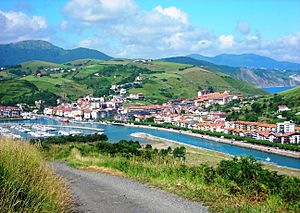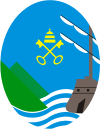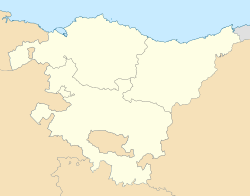Zumaia facts for kids
Quick facts for kids
Zumaia
|
|||
|---|---|---|---|
| Zumaia | |||
 |
|||
|
|||
| Country | Spain | ||
| Autonomous community | |||
| Province | Gipuzkoa | ||
| Comarca | Urola Costa | ||
| Founded | 1347 | ||
| Area | |||
| • Total | 11.28 km2 (4.36 sq mi) | ||
| Population
(2018)
|
|||
| • Total | 10,044 | ||
| Demonym(s) | Basque: zumaiarra | ||
| Time zone | UTC+1 (CET) | ||
| • Summer (DST) | UTC+2 (CEST) | ||
| Postal code |
20750
|
||
| Area code(s) | +34 (Spain) + 943 (Gipuzkoa) | ||
| Website | zumaia.eus | ||
Zumaia ([s̻umaja], Spanish: Zumaya) is a small town in the north of Spain. It is located in the Basque Country.
The town has two beaches, Itzurun and Santiago. These beaches are special for geologists. They show some of the longest continuous rock layers in the world. These rock formations are called flysch. They formed over 100 million years, from the mid-Cretaceous period until today. You can even find the K–T boundary at Itzurun beach. This boundary marks the time when dinosaurs disappeared. Fossils, like those of ammonites, can be found here. The rock layers stretch for about 8 kilometers between the beaches of Deba and Getaria, with Zumaia in the middle.
Zumaia is also home to a museum dedicated to the painter Ignacio Zuloaga. It displays art by famous painters like El Greco, Rivera, Zurbarán, and Goya. Across the street, there's a museum showing crafts and handmade items. In the town center, you can see the San Pedro church. It's a Gothic-style church with a beautiful altarpiece by Juan de Antxieta. This is the only work by this Basque sculptor found in Gipuzkoa.
Zumaia is located where the Urola and Narrondo rivers meet. The town grew around an old monastery. In the Middle Ages, people in the Sehatz valley faced many attacks from pirates. So, they built walls and strengthened the city for protection. The church still looks like a strong, defensive building today.
Contents
What's in a Name?
Many people think Zumaia's name comes from "zuma" or "zume." This is the Basque word for wicker, a plant that used to grow a lot in the area. The old name "Villagrana" might be linked to "grana," meaning "seeding." This could be because there were many evergreen oak trees back then.
A Look at Zumaia's Past
How Zumaia Began
Historians agree that Zumaia started around the Santa Maria Monastery. The first record mentioning "Zumaya" is from 1292. It says that Sancho VI of Navarre gave the Santa Maria Monastery to the Roncesvalles convent.
People living in the Sehatz valley decided to build a walled town. They wanted to protect themselves from constant pirate attacks. Zumaia was chosen because it was large, in a good location, and close to the sea. The town officially became "Villagrana de Zumaya's Villa" in 1347. This happened when Alfonso XI of Castile gave its citizens a special charter. The town was then connected to the laws of San Sebastián.
By the 1500s, Zumaia had 136 houses. About 70 of them were inside the town walls. The rest were in three neighborhoods outside the walls. Today, there are no signs of these old walls. The main gates were taken down in the mid-1700s to open up the town. The only natural entrance was from the sea.
The church bells have been melted and remade many times. In 1578, the mayor ordered them to ring three times. This was to make sure citizens came to town meetings. In 1620, Ignatius of Loyola was chosen as the patron saint of Gipuzkoa. On the same day, the Immaculate Conception of the Virgin Mary became Zumaia's patron saint.
Changes in the Economy
Over the centuries, Zumaia has changed a lot. The town's rules, buildings, and people's lives have all evolved. The main way people made money also changed over time.
- Early Days: Most of the first residents were farmers. But as more people gathered in one place, new jobs appeared. By the late 1300s, ships were built in the river. Many people worked in fishing and sailing. The river was full of fish like salmon, trout, and eels. Some people farmed and fished at the same time. Making cement also became important. They used materials from the nearby land for this. Goods were sent from the port to places like the Netherlands.
- 1600s and 1700s: These centuries were not easy for Zumaia. Farming was still the main activity, even though the town often didn't grow enough food. In 1766, houses were checked to make sure no one had more grain than they needed. Some people transported goods by sea and land, mostly iron. Fishing continued to be important. In 1610, the "Confraternity of the Seagoing of San Telmo" was created for sailors. Many people left Zumaia during this time, looking for better opportunities.
- 1800s and 1900s: Things started to get better in the 1800s. Marshes were drained, which meant more land for farming, especially corn. Cement factories became very important for the town's economy. This also boosted trade at the port. Transportation improved too. A road connecting Zumaia to Getaria was built between 1882 and 1885. A train line to Zarautz opened in 1900. The Urola railroad started in 1926, but it's gone now. Better transport, however, hurt the Bedua port. The Urola river bridge blocked ships from going upstream.
The cement industry slowed down in the early 1900s. But shipbuilding and engine manufacturing grew strong. Zumaia was even home to the first diesel engine in Spain! This growth brought many new people to the town. By 1950, over half of Zumaia's population worked in industry. Only 17% worked in farming. Later, an economic crisis hit Zumaia. Some big factories closed. Today, many smaller companies have started, fitting with new market trends.
Food and Culture
Octopus: A Zumaia Tradition
Octopus has been a special part of Zumaia's culture for a long time. This connection is unique compared to nearby towns like Getaria or Zarautz. Catching octopus along Zumaia's coast is a very old tradition. The octopus has become a symbol of the town's culture.
How to Fish for Octopus
People usually catch octopus in three main spots in Zumaia: the rocks at Itzurun beach, Inpernupe, and the coast between Zumaia and Deba. The best time to fish is when the tide is low. This is because octopuses hide in holes in the rocks. The more rocks you can see, the more chances you have to find them. You usually need a fish hook to grab the octopus. There are different ways to catch them:
- Spotting Clues: Look for remains of crabs or other small sea animals at the entrance of holes. This tells you an octopus might be inside. Then, you can use a hook to catch it.
- Using Bait: Some people use a stick with bait to attract octopuses. Once the octopus comes out to see the bait, you can grab it with the hook.
Catching octopus has been a family tradition for many in Zumaia. Some experienced fishers used to catch 100 octopuses in a day! But there are fewer octopuses now. Pollution, large fishing vessels, and years of unlimited fishing have harmed the coast. Because of this, the government now limits how many octopuses one person can catch. You can only catch one octopus per day, and it must weigh more than 750 grams.
When there are big tides, many people still go to the coast to fish for octopus. Even though it's illegal to catch more than one, some older people who have fished all their lives still catch many. Fresh octopus meat is tough. It needs to be frozen for at least a week to make it tender.
Fresh octopus can be cooked in different ways, like with tomatoes, "a la gallega" (Galician style), or with peppers and onion. These recipes are common in other places with fishing traditions, like Asturias or Galicia. But there's a special recipe from Zumaia that uses dried octopus. You won't find this tradition in other nearby towns.
Drying Octopus
Drying octopuses is a unique tradition in Zumaia. It's not common in most coastal towns. Here's how it's done:
- First, the octopus is cleaned after it dies.
- Then, it's left to dry in a bucket for 3 to 5 days.
- After that, it's put on a stick to dry for another 7 to 8 days.
During this process, the octopus can lose up to 80% of its original weight. It also gets a very strong smell!
Zumaia's Geological Heritage
Zumaia is home to a very important geological site. The "Cretaceous-Paleogene Stratigraphic Section of Zumaia" was named one of the top 100 "geological heritage sites" in the world in October 2022. This was done by the International Union of Geological Sciences (IUGS).
Why is it so special? It's considered one of the best places in the world to see, study, and understand deep ocean sediments. These rock layers have greatly helped scientists learn about Earth's history.
Images for kids
-
Lighthouse of Zumaia
See also
 In Spanish: Zumaya para niños
In Spanish: Zumaya para niños















